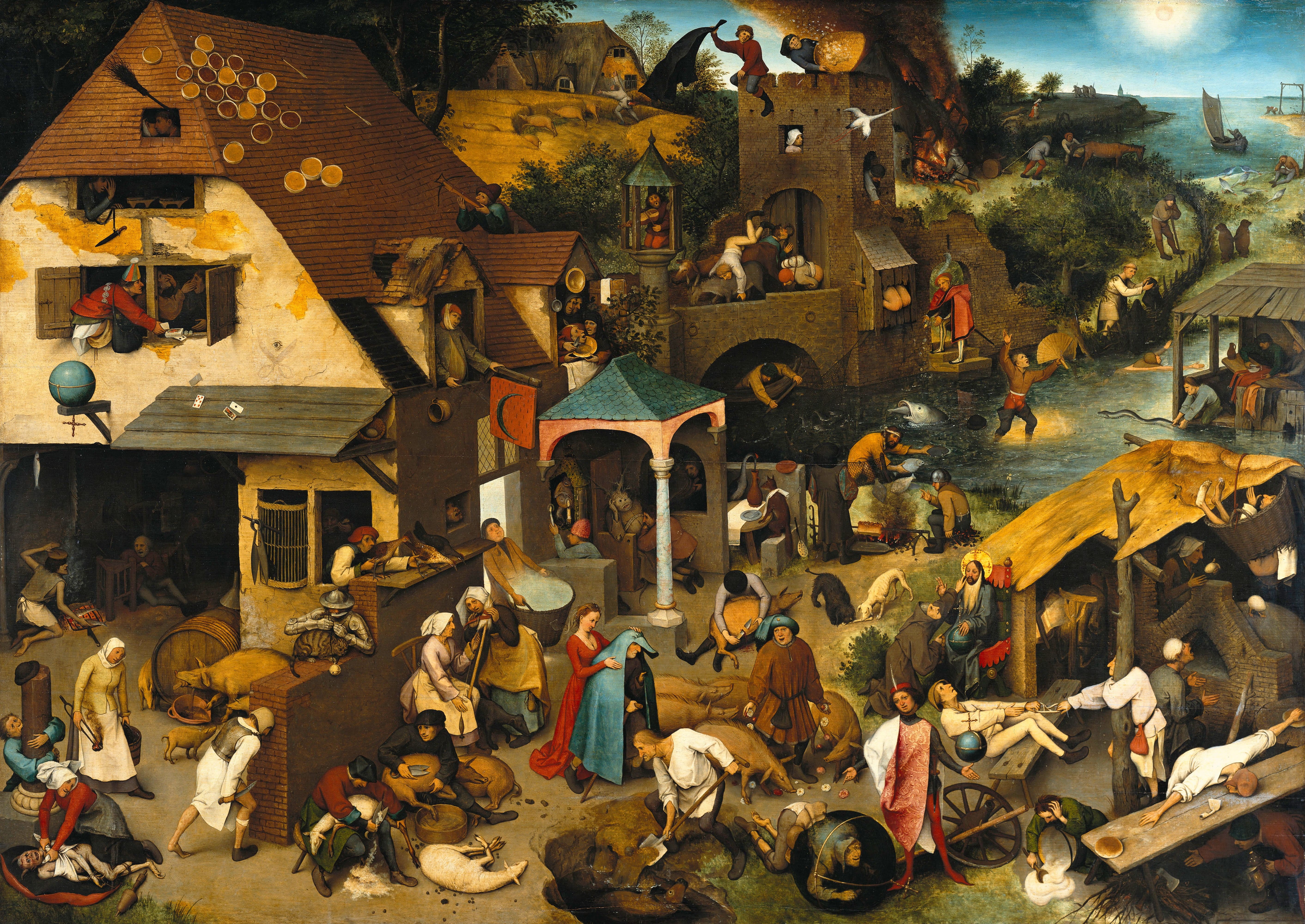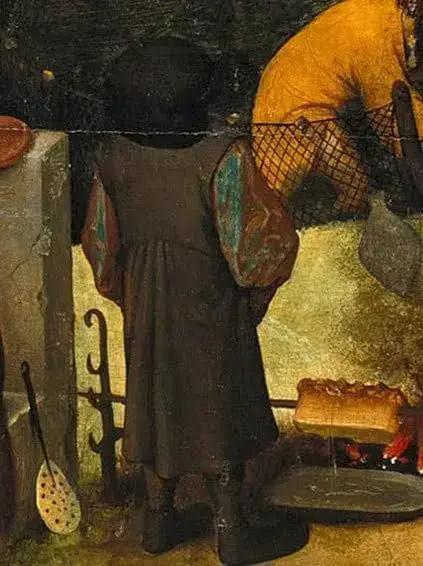I enjoy looking at the depiction of livestock in old artwork, particularly the pigs. The bustling “Netherlandish Proverbs” painting by Pieter Bruegel the Elder is delightful. It can be studied on many levels and it invites minute examination with its blending of highbrow irony and lowbrow bawdiness. But I’m neither historically nor artistically trained, so I’ll leave those topics for others. I’m here for the pigs. Although the painting is more emblematic and didactic than literal, what I pick up on here is the commonness of pigs in daily life. In our world of megacities and sprawling suburbs, people only know pigs from electronic and printed representations. They might see live pigs on rare trips to the zoo or to the petting farm, though these encounters necessarily contain some artifice and staging. But in the pre-digital and pre-industrial Low Countries (and in most of the rest of human habitation at that time), everyone encountered pigs and other livestock daily even if they didn’t personally raise them.

Pieter Bruegel knew how to draw animals. I find it fascinating that his pigs don’t look very different from his sheep. They are long legged, pointy headed, skinny in the hams and shoulders, and bloated in the gut. Their physique indicates the pigs are eating a high-roughage, low-calorie diet. The only pig that probably exceeds 200 pounds is the sow opening the beer cask. Half the pigs have tusks, which makes sense, since prominent tusks are a sexual dimorphic characteristic of males. The size of the tusks indicates that the larger pigs are all about two years old (any modern breed with a decent feed ration can achieve that size in six months).
In the 1700s and 1800s, European domestic hogs were crossed with Chinese hogs, probably something similar to the Meishan breed. The Asian genetics brought better fleshing ability and larger litter sizes, at a cost of a smaller frame. But within a few generations of selective breeding, the modern standard pig breeds emerged, combining the best characteristics of their diverse ancestry. This leads me to think about the push to preserve heritage breeds and the question about how far back we go with this preservation. Our heritage breeds once were novelty hybrids that displaced their rougher-edged predecessors. Are Berkshires heritage hogs or are Bruegel’s pigs heritage hogs or do we need to go back to their wild boar progenitors? We could grow all-forage, super-heritage, mostly-wild pigs, but could we ever sell rangy pork chops from Bruegel’s pigs? Could any farmer, other than someone who is able to take advantage of a super-specialized niche, make a living selling pigs that took four times as long to grow and reproduced at one third the rate of modern pigs?
It is easy to be glib about “heritage” farming being inherently “sustainable”, but in a world where farming is so far segregated from most of the population, where land prices, taxes, insurance, and regulatory overhead are expensive, and where profit margins are miniscule, farms need a level of productivity far higher than that which would have been required in previous centuries. Hybrid plants and modern livestock breeds seem to be the only option when I look around at farmers that are actually making a living from their work. I’d like to think that we could plant open-pollinated Calais Flint corn and heirloom broccoli, raise Highland Cattle and Buff Orpington chickens, but even with one of the most affluent markets in the world just a few hours from our door, I don’t see anyone supporting themselves from a strict “heritage” farm. The successful organic CSAs are growing hybrids of most crops, except for a few heirloom items to garnish the basket. One could wish that alternative agriculture would be more alternative, but the margins are so tight and the required volumes are so high that farmers can’t afford to choose the heritage path. The heritage route works well for the backyard garden where specific flavor or genetic diversity considerations can trump economics, but when one’s livelihood depends on it, the unsentimental logic of industrial production pulls us all inexorably in its direction. All farmers are living somewhere on that slippery slope, trying to figure out where we need to dig in our heels and go no further.
If we can accept that we are all skidding along the same slippery slope, then I’d like to take the opportunity to encourage openness. We all have our individual mental picture of ideal agriculture. We all have seen disastrous examples of agriculture gone bad. As farmers, we need to talk openly to our customers so they know our challenges and understand the places where idealism wears thin. We need to listen to understand what they really value and to find out how we can meet their needs. As customers, we need you to speak up and to tell your farmer what you are looking for. But be ready to listen if she tells you that you can’t get plump chicken breasts from soy-free, heritage breed chickens.
Sorry about bursting bubbles and all that. I’ll conclude with this sour detail from Bruegel.


4 thoughts on “Pigs in Art: Bruegel and Unachievable Farming Ideals”
This is one of my favorite posts you’ve written, perhaps because it aligns so closely with my thoughts about productivity on small farms, personal bias and all that. Did you read Garth’s post from almost a year ago that relates to the topic of this blog post? If you missed it here is the link – http://cairncrestfarm.com/breeding-dissension/
Thanks. I thought I read through your blog from end to end but I must have missed Garth’s post. The discussion about being a bewildered novice trying to sort through all the breed mythologies certainly rings true for me.
Once again, just loving your posts! Thanks for the eye opening art lesson as well as informative jaunt into your (and all of our!) world.
Thanks Brady. It’s helpful to get feedback on what topics resonate with you.